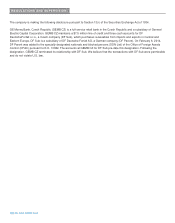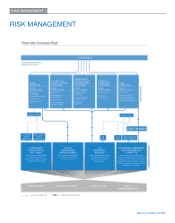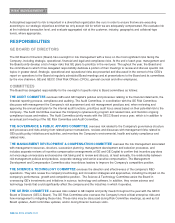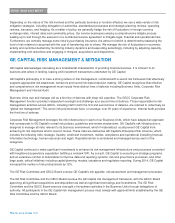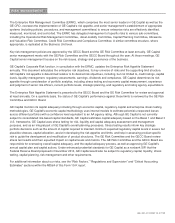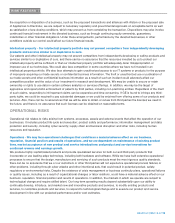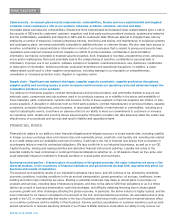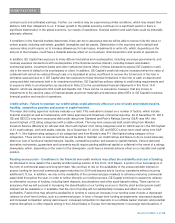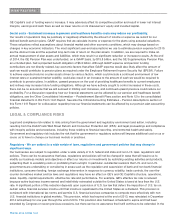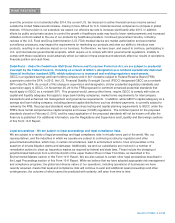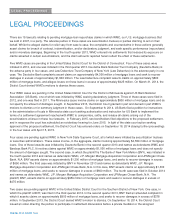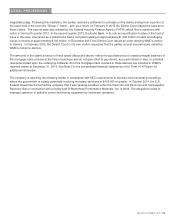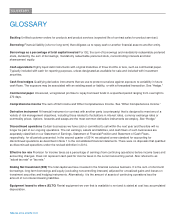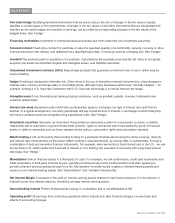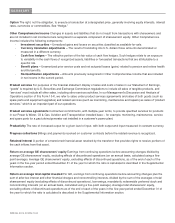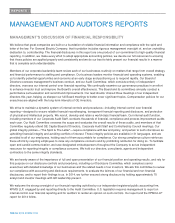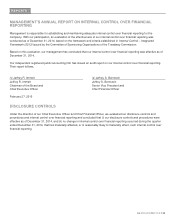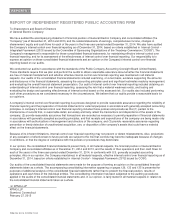GE 2014 Annual Report Download - page 136
Download and view the complete annual report
Please find page 136 of the 2014 GE annual report below. You can navigate through the pages in the report by either clicking on the pages listed below, or by using the keyword search tool below to find specific information within the annual report.
116 GE 2014 FORM 10-K
RISK FACTORS
GE Capital’s cost of funding were to increase, it may adversely affect its competitive position and result in lower net interest
margins, earnings and cash flows as well as lower returns on its shareowners’ equity and invested capital.
Social costs - Sustained increases in pension and healthcare benefits costs may reduce our profitability.
Our results of operations may be positively or negatively affected by the amount of income or expense we record for our
defined benefit pension plans. GAAP requires that we calculate income or expense for the plans using actuarial valuations.
These valuations reflect assumptions about financial market and other economic conditions, which may change based on
changes in key economic indicators. The most significant year-end assumptions we use to estimate pension expense for 2015
are the discount rate and the expected long-term rate of return on the plan assets. In addition, we are required to make an
annual measurement of plan assets and liabilities, which may result in a significant reduction or increase to equity. At the end
of 2014, the GE Pension Plan was underfunded, on a GAAP basis, by $15.8 billion, and the GE Supplementary Pension Plan,
an unfunded plan, had a projected benefit obligation of $6.6 billion. Although GAAP expense and pension funding
contributions are not directly related, key economic factors that affect GAAP expense would also likely affect the amount of
cash we would contribute to pension plans as required under the Employee Retirement Income Security Act (ERISA). Failure
to achieve expected returns on plan assets driven by various factors, which could include a continued environment of low
interest rates or sustained market volatility, could also result in an increase to the amount of cash we would be required to
contribute to pension plans. In addition, upward pressure on the cost of providing healthcare benefits to current employees
and retirees may increase future funding obligations. Although we have actively sought to control increases in these costs,
there can be no assurance that we will succeed in limiting cost increases, and continued upward pressure could reduce our
profitability. For a discussion regarding how our financial statements can be affected by our pension and healthcare benefit
obligations, see the Other Consolidated Information – Postretirement Benefit Plans section and Note 12 to the consolidated
financial statements in this Form 10-K Report. See also the Critical Accounting Estimates – Pension Assumptions section of
this Form 10-K Report for a discussion regarding how our financial statements can be affected by our pension plan accounting
policies.
LEGAL & COMPLIANCE RISKS
Legal and compliance risk relates to risks arising from the government and regulatory environment and action, including
resulting from the Dodd-Frank Wall Street Reform and Consumer Protection Act (DFA); and legal proceedings and compliance
with integrity policies and procedures, including those relating to financial reporting, environmental health and safety.
Government and regulatory risk includes the risk that the government or regulatory actions will impose additional cost on us or
cause us to have to change our business models or practices.
Regulatory - We are subject to a wide variety of laws, regulations and government policies that may change in
significant ways.
Our businesses are subject to regulation under a wide variety of U.S. federal and state and non-U.S. laws, regulations and
policies. There can be no assurance that laws, regulations and policies will not be changed in ways that will require us to
modify our business models and objectives or affect our returns on investments by restricting existing activities and products,
subjecting them to escalating costs or prohibiting them outright. In particular, substantial revisions that U.S. and non-U.S.
governments are undertaking or considering in areas such as the regulation and supervision of bank and non-bank financial
institutions, consumer lending, foreign exchange intervention in response to currency volatility, trade controls, the over-the-
counter derivatives market and tax laws and regulations may have an effect on GE’s and GE Capital’s structure, operations,
sales, liquidity, capital requirements, effective tax rate and performance. For example, GE’s effective tax rate is reduced
because active business income earned and indefinitely reinvested outside the United States is taxed at less than the U.S.
rate. A significant portion of this reduction depends upon a provision of U.S. tax law that defers the imposition of U.S. tax on
certain active financial services income until that income is repatriated to the United States as a dividend. This provision is
consistent with international tax norms and permits U.S. financial services companies to compete more effectively with non-
U.S. financial institutions in global markets. This provision, which had expired at the end of 2013, was reinstated in December
2014 retroactively for one year through the end of 2014. This provision also had been scheduled to expire and had been
extended by Congress on seven previous occasions, but there can be no assurance that it will continue to be extended. In the


